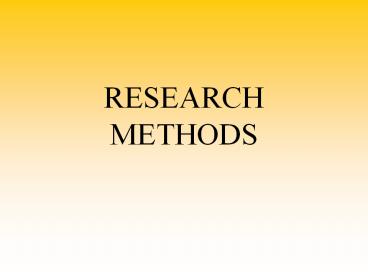RESEARCH METHODS - PowerPoint PPT Presentation
1 / 38
Title:
RESEARCH METHODS
Description:
RESEARCH METHODS Research Strategies Research Strategies Descriptive strategies for observing and describing behavior (answer who, what, when, where & how often ... – PowerPoint PPT presentation
Number of Views:850
Avg rating:3.0/5.0
Title: RESEARCH METHODS
1
RESEARCH METHODS
2
Research Strategies
3
Research Strategies
- Descriptivestrategies for observing and
describing behavior (answer who, what, when,
where how often) - Correlational methods
- Naturalistic observation
- Case studies
- Surveys
- Experimentalstrategies for inferring cause and
effect relationships among variables
4
Descriptive Study
- Describes a set of facts
- Does not predict what may influence the facts
- May or may not include numerical data
- Example measure the percentage of new students
from out-of-state each year since 1980
5
Case Study
- In depth study of one individual with the hopes
of determining universal principles - This technique is very open to bias
- Difficulty of applying data from one person to
everyone - Generally used to investigate rare, unusual, or
extreme conditions
6
Survey Method
- Research method that relies on self-reports uses
surveys, questionnaires, interviews. - Usually a very efficient and inexpensive method
- Watch out for Framing/Wording Effects The way a
question is worded can bias the answer. - Have to watch out what we take from polling
information http//www.ncpp.org/node/4/1 - Also, people lie in surveys http//www.responsibi
lityproject.com/blog/post/lying-to-pollsters-bad-v
ote/
7
SamplingTerms
- Populationlarge (potentially infinite) group
represented by the sample. Findings are
generalized to this group. - Sampleselected segment of the population
- Random selectionevery member of larger group has
equal chance of being selected for the study
sample - Random Sample - Each member of the population has
an equal chance of being included. - If a sample is not random it is said to be
biased. - Representative/Stratified sampleclosely
parallels the population on relevant
characteristics - Watch this short clip on the difference between
these. (3 min)
8
(No Transcript)
9
DAILY
- DOUBLE
10
QUESTIONExplain the difference between a random
sample and a representative sample.
- ANSWER
- Random sampleevery member of larger group has
equal change of being selected for the study
sample - Representative sampleclosely parallels the
population on relevant characteristics
11
Naturalistic Observation
- Method of observation where subjects are observed
in their natural environment - Subjects are not aware they are being watched
- Could use hidden cameras or two way mirrors
12
Meta-Analysis
- Combining the results from multiple different
research studies. - Example Studying lung cancer from second hand
smoke.
13
Bias
- Situation in which a factor unfairly increases
the likelihood of a researcher reaching a
particular conclusion - Bias should be minimized as much as possible in
research
14
Researcher Bias
- The tendency to notice evidence which supports
one particular point of view or hypothesis - Objectivity tends to reduce bias.
15
Participant Bias/ Hawthorne Effect
- Tendency of research subjects to respond in
certain ways because they know they are being
observed - The subjects might try to behave in ways they
believe the researcher wants them to behave - Can be reduced by naturalistic observation
16
Critical Thinking
- Thinking that does not blindly accept arguments
or conclusions but questions their validity - Need to do this to avoid bias
17
Longitudinal and Cross-Sectional Studies
18
Developmental Psychologists
- Psychologists who study how individuals change
throughout their lifetime
19
Longitudinal Study
- Developmental study where researchers study the
same group of individuals for many years - Can be very expensive and difficult to conduct
20
Cross-Sectional Study
- Developmental study where researchers
simultaneously study a number of subjects from
different age groups and then compare the results - Cheaper, easier than longitudinal studies, but
group differences may be due to factors other
than development.
21
Longitudinal/Cross Sectional Study
22
Correlational Study
- Collects a set of facts organized into two or
more categories - measure parents disciplinary style
- measure childrens behavior
- Examine the relationship between categories
- Correlation reveals relationships among facts
- e.g., more democratic parents have children who
behave better
23
Correlational Study
- Important NOT to imply a cause and effect
relationship between the variables - Correlational study does not determine why the
two variables are related--just that they are
related. - Correlational studies are helpful in making
predictions.
24
Correlational Study
- Correlation CANNOT prove causation
- Do democratic parents produce better behaved
children? - Do better behaved children encourage parents to
be democratic? - May be an unmeasured common factor
- e.g., good neighborhoods produce democratic
adults and well-behaved children - Doesnt mean they are not useful Correlation in
smoking (3 min)
25
(No Transcript)
26
(No Transcript)
27
(No Transcript)
28
Correlation Causation
- There is a strong .90 correlation in shoe size
and IQ. - Does this mean that a large shoe size is the
cause for higher intelligence? - What else could explain this?
- YOUR FEET GROW
- AS YOU GET OLDER
- WISER
29
Coefficient of Correlation
- Numerical indication of magnitude and direction
of the relationship between two variables - Positive correlationtwo variables vary
systematically in the SAME direction - Negative correlationtwo variables vary
systematically in OPPOSITE directions
30
How to Read a Correlation
31
Positive Correlation
- As the value of one variable increases (or
decreases) so does the value of the other
variable. - A perfect positive correlation is 1.0.
- The closer the correlation is to 1.0, the
stronger the relationship.
32
(No Transcript)
33
(No Transcript)
34
Negative Correlation
- As the value of one variable increases, the value
of the other variable decreases. - A perfect negative correlation is -1.0.
- The closer the correlation is to -1.0, the
stronger the relationship.
35
(No Transcript)
36
(No Transcript)
37
Zero Correlation
- There is no relationship whatsoever between the
two variables.
38
Lets Review































